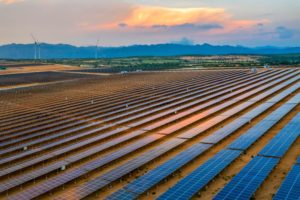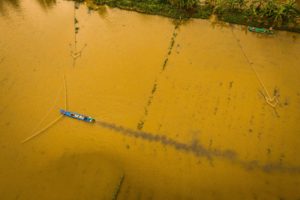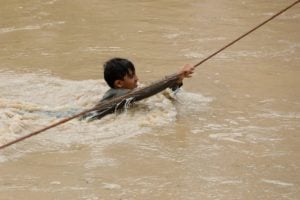On 23 June 2022, the import of 100 megawatts (MW) of hydropower from Laos to Singapore through Thailand and Malaysia was hailed as a historic milestone. Part of a pilot project known as the Lao PDR-Thailand-Malaysia-Singapore Power Integration Project (LTMS-PIP), this event represented Singapore’s first ever import of renewable energy, and also the first instance of cross-border electricity trade involving four countries from the Association of Southeast Asian Nations (ASEAN).
However, this development takes place amid rising concerns for the ecological future of the transboundary Mekong River and the millions of people who depend on it. A 2018 study by the Mekong River Commission concluded that further hydropower development on the river would negatively affect ecosystems, and would reduce soil fertility, rice production, fish yields and food security, while increasing poverty in the river basin.
The draw of hydropower and a regional power grid
For landlocked Laos, the recent export of energy to Singapore brings it one step closer to fulfilling its ambition to become the “battery of Southeast Asia” by harnessing the 23,000 MW of exploitable hydropower potential from the Mekong and its tributaries. Currently, Laos has more than 70 operational dams with a total generating capacity of 8,880 MW, of which two are on the Mekong’s mainstream. Seven more are in various stages of planning on the mainstream. According to Stimson’s Mekong Infrastructure Tracker, around 30 dams are under construction across Laos, and over 200 are planned.
Under the LTMS-PIP project, hydropower generated in Laos is exported to Singapore through a process called wheeling, in which the Thai and Malaysian power grids serve as transit points. The 100MW from Laos is exported directly into the Thai power grid, following which Thailand sends an equal amount of power into Malaysia’s grid, and Malaysia in turn sends the same amount of power to Singapore through high-voltage transmission systems.
Hydropower is a lucrative pillar of the Laotian government’s goal to lift the country out of its status as one of the world’s least developed countries. A 2010 assessment by the International Centre for Environmental Management found that if all proposed dams on the main Mekong River were to go ahead, Laos would earn up to USD 2.6 billion per year in export revenue.
In theory, establishing regional power grids connecting Mekong and ASEAN countries would enable power trading between countries such as Laos, which produces surplus energy, and energy-hungry countries such as Thailand and Vietnam. By 2021, out of Laos’ 10,400 MW total installed energy capacity, of which 80% is generated by hydropower dams, 5,421 MW was exported to Thailand and 572 MW was sold to Vietnam. Proponents describe regional grids as a way to promote economic growth, energy security and the development of renewable energy in Southeast Asia.
Yet, this might be taking place at the expense of the environment, natural resource-based livelihoods and food security. A 2018 study by Mae Fah Luang University in Thailand and the Australian National University estimated that the total external costs of the 11 planned mainstream dams on the lower Mekong would total USD 18 billion, and that the projects were not economically viable when weighed against the loss of capture fisheries, sediment, and social mitigation costs.
Large-scale dams as drivers of environmental injustice
The production of renewable energy, be it wind, solar or hydropower, requires the construction of infrastructure that incurs different degrees of impact on the environment.
Large hydropower dams are controversial in terms of their destructive effects on river systems, even more so in watersheds that span multiple countries and in the context of climate change. For more than a decade, communities who live on riverbanks in northern Thailand have reported fluctuating water levels they claim are caused by upstream dam operations on China’s section of the Mekong, which they say have influenced their dry-season livelihoods negatively.
Dams also block the supply of sediments that form fertile floodplains. A few weeks after the Xayaburi Dam in northern Laos became operational in October 2019, the usually-muddy Mekong turned clear blue, indicating that the river had become starved of nutrient-rich sediment.
In addition, Mekong hydropower dams block fish migration routes, threatening food security in one of the world’s largest inland fisheries. Fisheries account for up to 30% of Cambodia and Laos’ national protein supply, and fishers are overrepresented in poor and vulnerable communities in the lower Mekong basin.
These issues contribute to concern that the construction of large dams in the Mekong region is a significant driver of environmental injustice. Despite claims by the Laotian government that hydropower dams are built in line with safeguards to mitigate their impact, a wide range of academic studies have demonstrated otherwise. The cases of the Nam Theun 2 project, which was supported by the World Bank and touted as a ‘model’ for dam-building in Laos, the Theun-Hinboun dam, and the collapse of the Xe Pian-Xe Namnoy dam in 2018 have demonstrated that the Laos government’s weak capacity in regulating hydropower dam construction has contributed to the creation of vulnerability among affected communities.
Dam construction along the Mekong and its tributaries takes place amid weak social and environmental safeguards; poor-quality environmental impact assessments that fail to fully account for the transnational and cumulative effects of hydropower development; and a lack of meaningful public participation in decision-making. Meanwhile, few avenues are available for affected communities to seek compensation for losses in livelihoods.
Sustainability beyond borders
By supporting the hydropower industry in Laos, Singapore’s energy import will inflict environmental harm and injustice on the Mekong’s ecosystems and the millions of people who depend on the river for their livelihoods and food security. But it is also in Singapore’s national interests to consider transboundary environmental sustainability.
Firstly, the long-term sustainability of hydropower dams on the Mekong is doubtful, given the uncertainties of climate change that may cause prolonged droughts and water shortages, as seen from 2019 to 2021, when water levels fell unprecedentedly low. The cumulative effects of climate change in conjunction with dam-building by a range of uncoordinated private operators may result in operators being unable to fulfil their power-generation targets.
Secondly, Singapore’s food security might be impacted. In 2020, almost 65% of its rice was imported from the lower Mekong region, with the majority coming from Thailand Vietnam providing about 20%. Given the threat that hydropower development poses to sediment flow and therefore agricultural productivity, Singapore – and other countries – should consider the trade-offs between energy, water and food in the region carefully.
The long-term sustainability of hydropower dams on the Mekong is doubtful, given the uncertainties of climate change
Lastly, hydropower development is closely tied to geopolitical dynamics in Southeast Asia, particularly China’s economic and political influence. China is the second-largest investor in Laos’ power-generation sector after Thailand. Concerns over Laos’ high level of indebtedness to China were heightened in 2021, when the Laotian government granted a 25-year concession to a Chinese company to build, manage and control its power grid. The country’s high levels of dependency on Chinese investment in its hydropower and power-generation sector may have knock-on effects on ASEAN unity when it comes to managing the association’s complicated relationship with China in other areas.
On the surface, Singapore’s decision to import renewable energy appears to be a useful way to meet its climate goals. Its National Climate Change Secretariat notes that more than 95% of Singapore’s energy is fuelled by natural gas. The island nation’s options to decarbonise its energy sector through reducing its fossil fuel dependency is limited by its small land size and lack of natural resources. Similarly, renewable energy plays a growing role in Thailand’s Power Development Plan, and in 2021 Thailand agreed to buy electricity from an additional three planned Mekong mainstream dams in Laos. However, it is worth noting that the strong environmental movements against dams in Thailand have contributed to these decisions to import hydropower instead. It will serve these countries well to reconsider whether imported Laotian hydropower can truly be considered ‘sustainable’.









